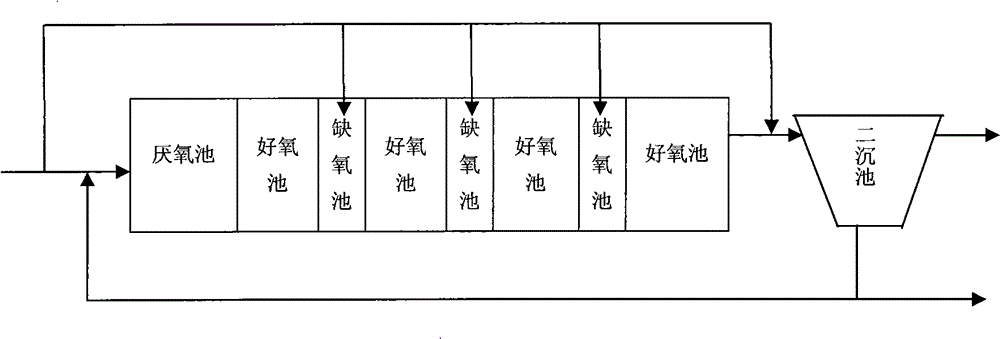Anaerobic multi-stage aerobic-anoxic dephosphorization and denitrification process
A high-level aerobic and denitrification technology, which is applied in the field of anaerobic multi-level aerobic anoxic phosphorus removal and denitrification process, can solve the problems of increasing investment and operating costs, slow growth of nitrifying bacteria, long nitrification time, etc., and achieve reduction The effect of building volume, improving capture rate and saving investment
- Summary
- Abstract
- Description
- Claims
- Application Information
AI Technical Summary
Problems solved by technology
Method used
Image
Examples
Embodiment Construction
[0009] As shown in the attached picture, the sewage enters in two parts, one part of about 30% of the sewage is mixed with the sludge backflow and then enters the anaerobic tank, and most of the sewage goes beyond the anaerobic tank and directly enters the aerobic tank connected to multiple points. Multiple anoxic pools are used for denitrification, and there are 1 to 19 water inlet points beyond the anaerobic pools to enter multiple anoxic pools. After the denitrification is completed, the remaining small part of sewage and the mixed solution flowing out of the last aerobic tank enter the secondary sedimentation tank for mud-water separation, and the remaining small part of sewage that goes beyond the biological reaction tank and directly enters the secondary sedimentation tank is 5% to 20%. During the mud-water separation process, the denitrification reaction is continued to reduce the nitrite nitrogen and nitrate nitrogen in the return sludge and effluent, and the excess slu...
PUM
 Login to View More
Login to View More Abstract
Description
Claims
Application Information
 Login to View More
Login to View More - R&D
- Intellectual Property
- Life Sciences
- Materials
- Tech Scout
- Unparalleled Data Quality
- Higher Quality Content
- 60% Fewer Hallucinations
Browse by: Latest US Patents, China's latest patents, Technical Efficacy Thesaurus, Application Domain, Technology Topic, Popular Technical Reports.
© 2025 PatSnap. All rights reserved.Legal|Privacy policy|Modern Slavery Act Transparency Statement|Sitemap|About US| Contact US: help@patsnap.com

